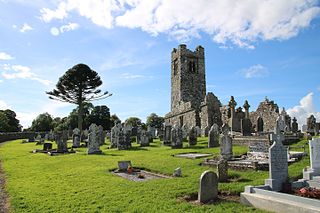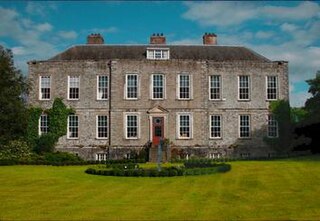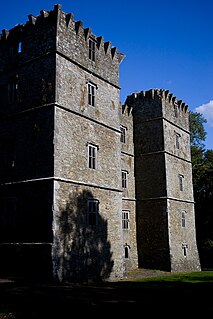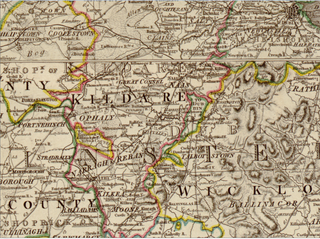
Slane is a village in County Meath, in Ireland. The village stands on a steep hillside on the left bank of the River Boyne at the intersection of the N2 and the N51. As of the 2016 census, Slane's population was 1,369. The village and surrounding area contains many historic sites dating back over 5,000 years. The village centre, as it is laid-out today, dates mainly from the 18th century.

Carnaross or Carnaros is a village in County Meath, Ireland, approximately 4 km northwest of Kells on the R147 road between Kells and Virginia, County Cavan.

Moynalty is a village in the north-west of County Meath in Ireland. It is located at the junction of the R194 and R164 regional roads 8 km (5 mi) north of Kells, near the border with County Cavan. It was part of the Kells Poor Law Union. The Borora river flows through the village. Its population in 2011 was 116 people.

Cusack is an Irish family name of Norman origin, originally from Cussac in Guienne (Aquitaine), France. The surname died out in England, but is still common in Ireland, where it was imported at the time of the Norman invasion of Ireland in the 12th century.

Naul, is a village, townland, and civil parish at the northern edge of Fingal and the traditional County Dublin in Ireland. The Delvin River to the north of the village marks the county boundary with County Meath. Naul civil parish is in the historic barony of Balrothery West.

Ballycarbery Castle is a castle 3 kilometres (2 mi) from Cahersiveen, County Kerry, Ireland. The castle is high on a grass hill facing the sea and is a short distance from Cahergall Fort and Leacanabuile Fort.
Ballinlough Castle is a 17th-century country house situated near the rural town of Clonmellon in County Westmeath, Ireland on a hill overlooking two of the Westmeath lakes. It is the home of Sir Nicholas and Lady Nugent.

Summerhill is a designated heritage village in County Meath, Ireland. It is located at the intersection of the R156 and R158 regional roads and is part of the Laracor civil parish. The Irish version of the town's name means "Lynch's Hill", and it was the ancestral home of the Norman-Irish Lynch family, whence came the Galway merchant family of the same name - one of the "Tribes of Galway". It is also the site of one of the most important battles in 17th century Ireland, the Battle of Dungan's Hill. The town was known in English as 'The Knock' or 'Lynchs' Knock' until about 1667 when it was renamed Summerhill. The ruins of the large Lynch castle can be seen in the village today.

Dardistown Castle is a castle and country house situated in parkland near Julianstown in County Meath, Ireland a few miles south of Drogheda.

Castlemartin is the name of a historic house and estate, and the townland in which they sit, on the banks of the River Liffey in Kilcullen, County Kildare, Ireland. Formerly a key estate of the Eustace family, it was for many years the home of media magnate Tony O'Reilly, and his wife, Chryss Goulandris, but was bought in 2015 by John Malone, an Irish American. The estate includes major stud farm and cattle breeding operations, a restored medieval church and an icehouse.

Ashbourne, historically called Killeglan or Kildeglan, is a town in County Meath, Ireland. Located about 20 km north of Dublin and close to the M2 motorway, Ashbourne is a commuter town within Greater Dublin. In the 20 years between the 1996 and 2016 census, the town almost tripled in population from approximately 4,900 to 12,700 inhabitants. The town is passed by the Broad Meadow Water, which comes from Ratoath and Dunshaughlin.

In Ireland at the end of the sixteenth and beginning of the seventeenth century, the fortified house, along with the stronghouse, developed as a replacement for the tower house. 'Fortified Houses' were often rectangular, or sometimes U or L-shaped, three-storey structures with high gables and chimney stacks and large windows with hood mouldings. Some examples have square towers at the corners. The interiors were relatively spacious with wooden partitions and numerous fireplaces. In a number of cases 'Fortified Houses' were built onto pre-existing tower houses. 'Fortified Houses' were protected by gun fire from the angle towers and bartizans, and were also provided with bawn walls with gunloops, towers and protected gateways. 'Fortified Houses' were built throughout Ireland by large landowners from a variety of backgrounds, such as the Old English Earl of Clanricarde who built Portumna Castle in County Galway; Gaelic lords such as MacDonogh MacCarthy, Lord of Duhallow, who built Kanturk Castle in County Cork; and Cromwellian soldiers such as Sir Charles Coote, who built Rush Hall in County Offaly.
Over the past six decades studies concerning Irish 'Fortified Houses' have identified them as a transitional genre that emerged at the end of the sixteenth century and acted as an architectural bridge between the Irish medieval tower-house and the country manor house of the late seventeenth century. The 'Fortified House' drew on the earlier tradition of the tower-house and was influenced by the Tudor and emerging Jacobean architecture from England and the Classical and Military architecture coming from Continental Europe. The social, political and military changes that took place from the 1580s-1650s were to play a major role in the development of this unique Irish structure. These houses provided a comfortable living space for the elite of early seventeenth-century Irish society. They were fashionable yet defendable. The 'Fortified House' was a public display of power and wealth. They represented a long term investment in their owner’s regional future and were monuments to an aspiration for an English and Continental house style suited to local Irish conditions. On a basic level the construction of a 'Fortified House' represented the owners’ desire to modernise and Anglicize.

The M.V. Gannon House was an historic home located on the east side of Davenport, Iowa, United States. It was listed on the National Register of Historic Places in 1983.
The High Sheriff of Cavan was the British Crown's judicial representative in County Cavan, Ireland from the 16th century until 1922, when the office was abolished in the new Free State and replaced by the office of Cavan County Sheriff. The sheriff had judicial, electoral, ceremonial and administrative functions and executed High Court Writs. In 1908, an Order in Council made the Lord-Lieutenant the Sovereign's prime representative in a county and reduced the High Sheriff's precedence. However the sheriff retained his responsibilities for the preservation of law and order in the county. The usual procedure for appointing the sheriff from 1660 onwards was that three persons were nominated at the beginning of each year from the county and the Lord Lieutenant then appointed his choice as High Sheriff for the remainder of the year. Often the other nominees were appointed as under-sheriffs. Sometimes a sheriff did not fulfil his entire term through death or other event and another sheriff was then appointed for the remainder of the year. The dates given hereunder are the dates of appointment. All addresses are in County Cavan unless stated otherwise.
The High Sheriff of Meath was the British Crown's judicial representative in County Meath, Ireland, from the conquest until 1922, when the office was abolished in the new Free State and replaced by the office of Meath County Sheriff.

The High Sheriff of Kildare was the British Crown's judicial representative in County Kildare, Ireland from the 16th century until 1922, when the office was abolished in the new Free State and replaced by the office of Kildare County Sheriff. The High Sheriff had judicial, electoral, ceremonial and administrative functions and executed High Court Writs. In 1908, an Order in Council made the Lord Lieutenant the Sovereign's prime representative in a county and reduced the High Sheriff's precedence. However the sheriff retained his responsibilities for the preservation of law and order in the county. The usual procedure for appointing the sheriff from 1660 onwards was that three persons were nominated at the beginning of each year from the county and the Lord Lieutenant then appointed his choice as High Sheriff for the remainder of the year. Often the other nominees were appointed as under-sheriffs. Sometimes a sheriff did not serve his full term due to death or another event, and another sheriff was then appointed for the remainder of the year. The dates given in this article are the dates of appointment.
Peter Joseph O'Reilly was an Irish-born bishop of the Catholic Church in the United States. He served as an auxiliary bishop of the Diocese of Peoria from 1900 to 1923.

Athlumney Castle is a tower house and fortified house and a National Monument in Navan, Ireland.

Donore Castle is a tower house (caiseal) and National Monument in County Meath, Ireland.
The 1950 Meath Senior Football Championship is the 58th edition of the Meath GAA's premier club Gaelic football tournament for senior graded teams in County Meath, Ireland. The tournament consists of 8 teams. The championship starts with a divisional stage and then progresses to a final.
















